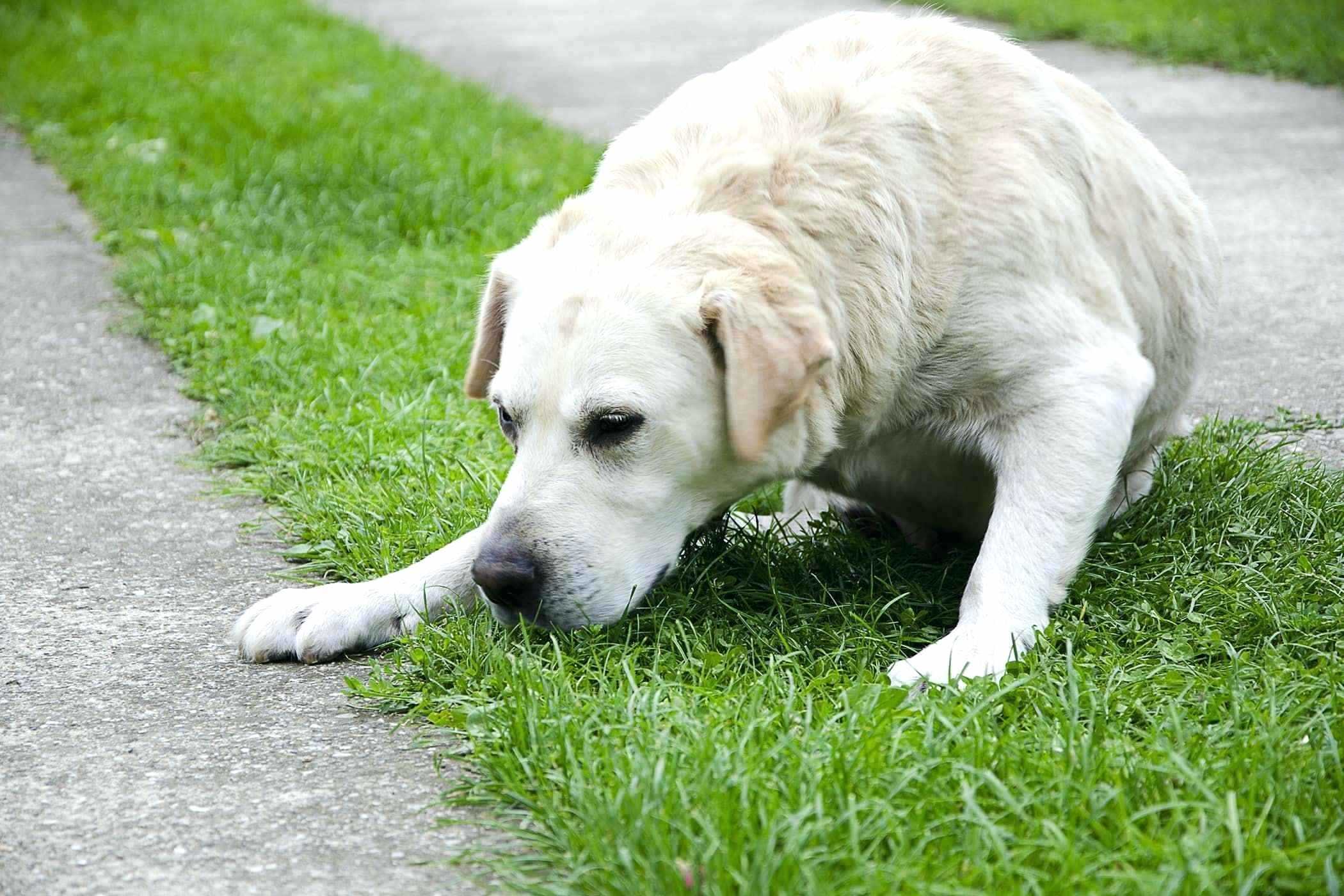Vomiting is very common in dogs. If the dog vomits once or twice, don’t panic. Is the dog throwing up all the time? Then he needs to be treated by a veterinarian. You can find everything about possible causes, diagnostics, and corrective actions if the dog throws up in this article.
Nausea, retching, vomiting: the process of throwing up

Dogs are slingers. They gobble the food without checking to see if it’s digestible. Control takes place in the stomach. The dog just throws up if the food isn’t right. Before vomiting, the dog feels severe nausea. He produces more saliva and constantly licks his lips. To speed up vomiting, the dog begins to eat grass. The dog pulls its back up, and the abdominal muscles and diaphragm contract. The contractions push the contents of the stomach down the esophagus and into the mouth. The four-legged friend lowers his head with his mouth open, the stomach contents flow out of the mouth.
What to do if the dog’s vomiting?
If the vomiting lasts only a short time, there is no need to worry. The dog should not eat the vomit again.
Dog vomiting: These are possible causes
The dog throws up after eating something intolerable that irritates the stomach. Apart from this protective mechanism, the dog often vomits for other reasons.
The dog is vomiting
Some dogs literally pounce on the food bowl. The food is eaten completely in a few minutes and immediately vomited up again undigested. With this form of vomiting, there is no nausea. The dog eats the vomit again.
Foreign bodies or an intestinal obstruction

If there is a foreign body in the stomach or intestines, the mucous membrane is irritated. Gas builds up in the intestine due to the obstruction. The dog is sick. The dog throws up. If the damage to the intestines continues, the feed is refused. The dog only vomits white or yellow foam.
How do you recognize a torsion in the dog’s stomach?
The dog salivates and tries to vomit. No stomach contents run out of his mouth. The mucous membranes are pale, the circulation breaks down. The dog is in pain.
Gastritis: Inflammation of the stomach lining
The dog throws up when the stomach lining is inflamed. Light white foam is usually vomited, consisting of gastric juice and air sacs. A common cause of stomach irritation is stress. But parasites, grass, or hair can also trigger vomiting.
When is dog vomiting dangerous?
If the vomiting lasts for a long time or keeps coming back, an illness is probably the cause. An alarm signal is pain and tremors.
Many infectious diseases are accompanied by vomiting and diarrhea. Salmonella, Campylobacter, or Escherichia coli can cause severe vomiting. When there is an infection, the body temperature is always elevated. The four-legged friend often has a fever and is listless.
Dog throws up from poisoning
Many poisons cause severe nausea. The dog’s body wants to get rid of the harmful substance quickly.
Liver and kidney diseases
If the metabolic end-products can no longer be excreted, they accumulate in the blood and tissue. The dog throws up.
When is dog vomiting dangerous?
If the vomiting lasts for a long time or keeps coming back, an illness is probably the cause. An alarm signal is pain and tremors.
Types and manifestations of vomiting
Vomiting can be acute or chronic depending on the underlying disease. In acute vomiting, the dog throws up a few times. Then everything is fine again. If the vomiting lasts longer than two days, the vomiting is chronic. The stomach lining is already damaged.
Peripheral vomiting
The dog throws up because it has a problem with its stomach. The gastric mucosa is irritated and inflamed due to excessive production of gastric acid. If left untreated, a stomach ulcer can develop. In the worst case, a gastric perforation occurs.
Central Vomiting
The dog throws up because the vomiting center in the brain is being stimulated. An example of central vomiting is motion sickness. The dog cannot make a connection between the rocking of the car, the scenery flying by, and sitting quietly in the back seat. His vestibular organ gets confused and sends the wrong signals to the brain. The dog throws up.
Central vomiting also occurs with encephalitis.
Vomiting can also be classified according to frequency and severity.
With mild or mild vomiting, the dog vomits once or twice.
Moderate vomiting means the dog is throwing up several times a day.
If vomiting is severe, the dog vomits every ten minutes. Even if there is nothing left in the stomach, the saliva continues to run out of the dog’s mouth. The choking continues.
When should you go to the vet if your dog is vomiting?
If the dog has a fever or if its behavior has changed, a veterinarian should be consulted.
When should you go to the vet if your dog is vomiting?

If the dog has a fever or if its behavior has changed, a veterinarian should be consulted.
Dog throws up: Diagnostics
After the clinical examination by a veterinarian, blood is drawn from the dog. The blood test can be used to determine the functions of the individual organs and the inflammatory values. The hematocrit (number of solid blood components) provides information about the degree of fluid loss.
If a foreign body is suspected, a contrast X-ray must be taken. The dog is given barium sulfate, which is distributed throughout the digestive tract within 12 hours. If there is a foreign body in the stomach or intestines, the flow of the contrast medium is impeded.
The vet uses an ultrasound to check the layer structure of the stomach and intestinal mucosa. Tumors or changes in the individual layers of the stomach (ulcers or tears) can be shown well.
What can you do to calm your dog’s stomach?
Stomach protection or the Morosche carrot soup soothes the dog’s stomach and protects the mucous membrane.
Instructions: What helps and how can you prevent it?
In the event of acute vomiting, the dog should not be given any food or treats for a few hours. So that he does not lose too much liquid, the four-legged friend should drink as much as possible. Water that is mixed with chamomile tea or with an eyebright solution (Euphrasia) is well suited here. Both plants have a calming effect on the gastric mucosa.
Moro’s carrot soup contains ingredients that attach themselves to the mucous membrane of the digestive tract and thus protect the mucous membrane. Healing takes place more easily.
What can you do to calm your dog’s stomach?
Stomach protection or the Morosche carrot soup soothes the dog’s stomach and protects the mucous membrane.
How do you recognize a torsion in the dog’s stomach?
The dog salivates and tries to vomit. No stomach contents run out of his mouth. The mucous membranes are pale, the circulation breaks down. The dog is in pain.
How can you prevent the dog from throwing up?

The dog needs healthy and animal-friendly dog food that contains all the nutrients it needs. At high temperatures, wet food should never be left uncooled for too long, as the bacteria it contains can multiply quickly. Food that is too cold irritates the stomach. To prevent the dog from throwing up, the food should be at room temperature.
Dry food should be fed in small portions and soaked in a little water. If the food is softer before eating, it will irritate the stomach less. The dog does not drink such large amounts of water after eating and does not overload the stomach.
Dogs eating too quickly can be prevented by using an anti-sling bowl or by raising the feeding bowl.



























